Animal Kingdom NEET Notes: Have you ever wondered how millions of animals around us, from buzzing bees to mighty lions, are classified in biology? Scientists have divided all living organisms into five kingdoms, and the Animal Kingdom is one of the most important among them. This chapter in NEET introduces you to the fascinating diversity of animals, their classification, and unique features, from the simplest sponges to highly developed mammals. To help students learn quickly, we have created well-structured NEET notes in simple language. These notes make revision easier, improve understanding, and save valuable time. Scroll down to access the best Animal Kingdom notes for NEET preparation.
Definition of the Animal Kingdom?
The Animal Kingdom is one of the five kingdoms in the biological classification system that includes all multicellular, eukaryotic, and heterotrophic organisms. Animals cannot prepare their own food, so they depend on plants or other organisms for nutrition. They show great diversity in structure, organization, and mode of life. Most animals are capable of movement, have specialized tissues, and reproduce sexually.
The Animal Kingdom is divided into two major groups: invertebrates (animals without a backbone) and vertebrates (animals with a backbone). Each group is further classified into different phyla based on features like body symmetry, body cavity, level of organization, and segmentation. Studying the Animal Kingdom helps us understand evolution, biodiversity, and the interdependence of living organisms.
Animal Kingdom is divided into two major groups: Invertebrates & Vertebrates
The Animal Kingdom is vast and diverse, with millions of species living on land, in water, and in the air. Scientists intended to make the study of animals easier, so they divided animals into 2 categories (or groups): vertebrates and invertebrates. The distinction is made based on whether or not an animal has a backbone.
What are Vertebrated?
Vertebrates are animals with backbones or spinal columns. Vertebrates include Amphibia, Aves (birds), Pisces (fish), Reptilia, and Mammalia (mammals). They tend to have a more elaborate body system and a stiff skeleton. Vertebrates usually show advanced features like a closed circulatory system, a Complex brain, and an endoskeleton.
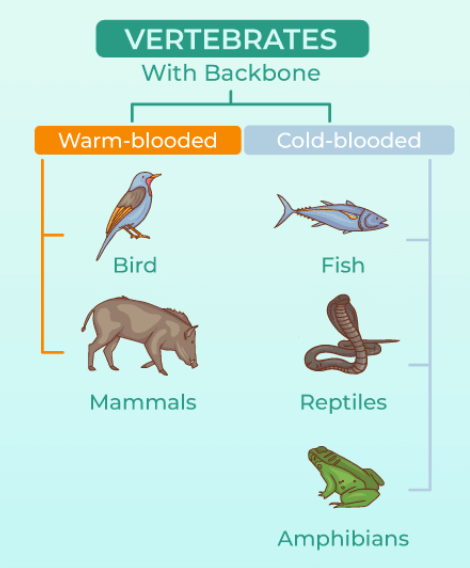
What are Invertebrates?
Invertebrates are animals that do not have a backbone. They can be soft-bodied or have an exoskeleton (as in insects, worms, and jellyfish). The majority of animal species on Earth are invertebrates. Porifera, Coelenterata, Platyhelminthes, Annelida, Arthropoda, Mollusca, Echinodermata, and many more are kept under the Invertebrates group.
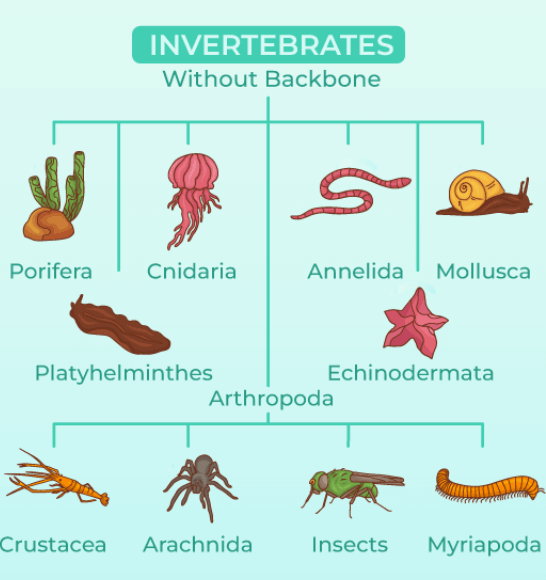
Characteristic Features of Animal Kingdom
Animals are often considered the most interesting group in the 5-kingdom classification system because the kingdom is rich in species, ranging from tiny sponges to enormous whales! All animals have some basic characteristics that set them apart from plants, fungi, and all other living organisms. They have diversity of form, structure, and habitat, but there are recognized common characteristics. The important characteristics that indicate that an organism is part of the animal kingdom are:
- Multicellular & Eukaryotic – Animals are made of many cells with a true nucleus.
- Heterotrophic – They cannot make their own food and depend on plants or other animals.
- No Cell Wall – Unlike plants, animal cells lack a cell wall, which makes them flexible.
- Tissue Organization – Most animals have well-organized tissues, organs, and organ systems.
- Motility – Animals can move from one place to another at some stage of life.
- Sexual Reproduction – Mostly reproduce sexually, showing gametes and fertilization.
- Diploid Life Cycle – The adult body is diploid (2n).
- Growth Pattern – Shows definite growth and development with cell differentiation.
- Nervous System & Sensory Organs – Well-developed in higher animals for response to stimuli.
Basis of Classification in Animal Kingdom
The classification of animals in the Animal Kingdom is based on certain fundamental features that help scientists to group them into different phyla. These criteria make it easier to study animals in a systematic and scientific way. The main basis of classification are:
| Basis of Classification in Animal Kingdom | |
| Main Basis of Classification | Description |
| Levels of Organization | Cellular, tissue, organ, and organ system levels of body organization. |
| Body Symmetry | Animals may be asymmetrical, radially symmetrical, or bilaterally symmetrical. |
| Germ Layers | Number of layers formed during embryonic development: diploblastic (two layers) or triploblastic (three layers). |
| Coelom | Presence or absence of a body cavity: acoelomates, pseudocoelomates, and coelomates. |
| Notochord | The presence or absence of a notochord divides animals into chordates and non-chordates. |
| Segmentation | The body may be segmented (metamerism) or unsegmented. |
| Circulatory System | Open type (blood flows in spaces) or closed type (blood flows in vessels). |
Phylum-Wise Notes for Animal Kingdom
The Kingdom Animalia includes all multicellular, eukaryotic, and heterotrophic animals. It is divided into different phyla based on features like body structure, symmetry, and presence of a notochord. Studying phylum-wise notes helps students understand diversity, adaptations, and evolutionary relationships in a clear and systematic way.
Phylum Porifera
- These are the simplest multicellular animals.
- Their bodies have tiny pores (ostia) through which water enters and circulates.
- They have a water canal system that helps in food collection, respiration, and excretion.
- They lack true tissues and organs but have a cellular level of organization.
- Examples: Sycon, Spongilla, Euspongia.
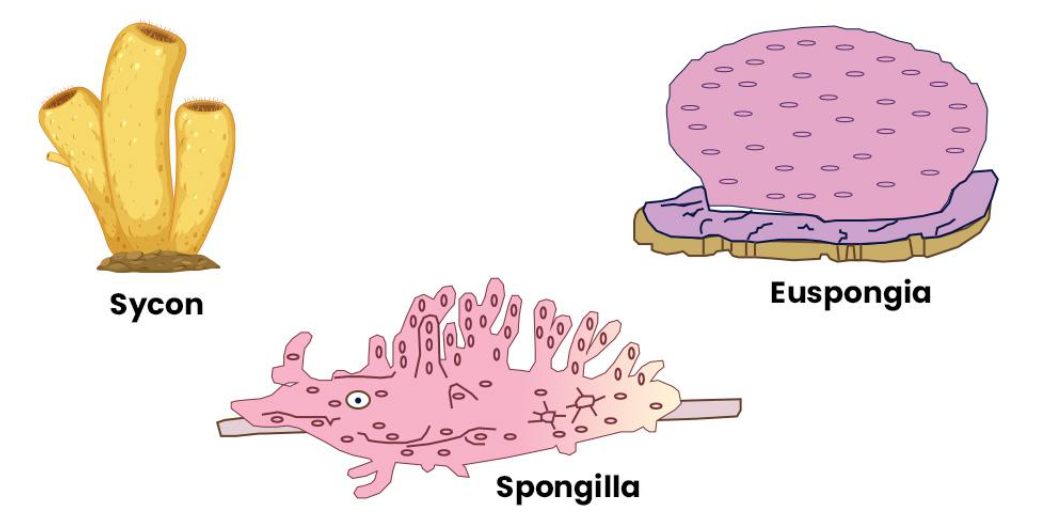
Phylum Coelentrata (Cnidaria)
- These animals are diploblastic (two germ layers).
- They show radial symmetry.
- Have cnidoblasts (stinging cells) used for defense and capturing prey.
- Body forms can be either polyp (Hydra) or medusa (Jellyfish).
- Examples: Hydra, Aurelia (Jellyfish), Obelia.
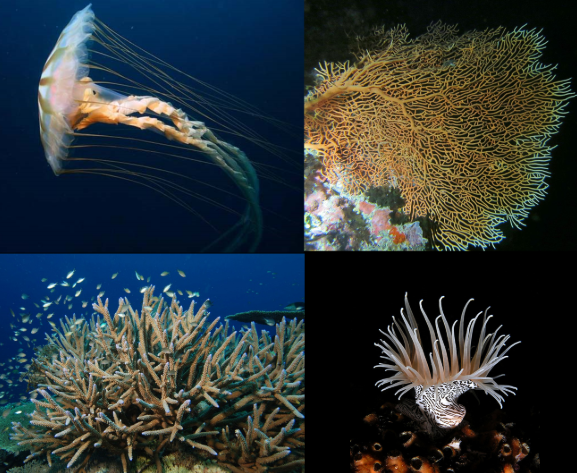
Phylum Arthropoda
- The largest phylum in the Animal Kingdom.
- The body is divided into the head, thorax, and abdomen.
- Have a chitinous exoskeleton and jointed appendages.
- They have an open circulatory system, but high adaptability makes them successful.
- Examples: Butterfly, Cockroach, Prawn, Spider, Crab.
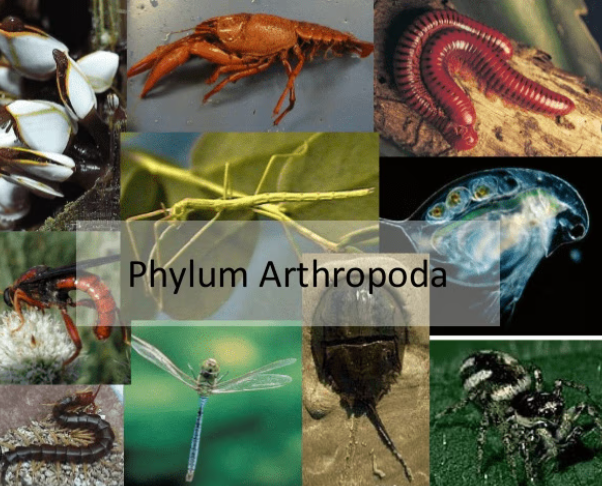
Phylum Mollusca
- Soft-bodied animals, mostly covered by a calcareous shell.
- The body is divided into the head-foot, visceral hump, and mantle.
- They have a specialized rasping organ called a radula (except in bivalves).
- The circulatory system is mostly open (except in octopus & squid).
- Examples: Octopus, Snail, Pila, Pearl Oyster.
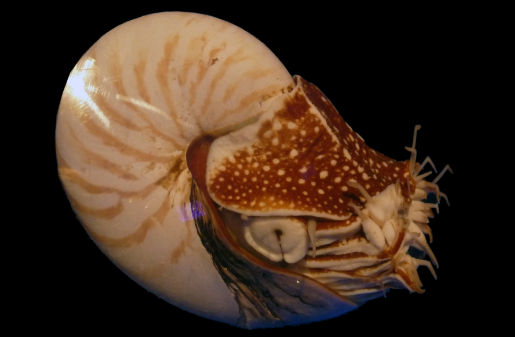
Phylum Annelida
- The body is metamerically segmented (divided into repeating units).
- True body cavity (coelom) is present.
- They have a closed circulatory system and well-developed organ systems.
- Show locomotion using setae or parapodia.
- Examples: Earthworm, Leech, Nereis.
Phylum Echinodermata
- Marine animals with spiny skin.
- Endoskeleton made of calcium carbonate.
- Adults show radial symmetry, but larvae are bilateral.
- They move using a water vascular system and tube feet.
- Examples: Starfish, Sea urchin, Brittle star.
Phylum Platyhelminthes (Flatworms)
- They are triploblastic and show bilateral symmetry.
- Their body are flat and leaf-like without a true body cavity (acoelomate).
- Many are parasitic and absorb nutrition directly from the host.
- Some show regeneration ability (like Planaria).
- Examples: Taenia (Tapeworm), Fasciola (Liver fluke), Planaria.
Phylum Nematoda
- The body is cylindrical, elongated, and unsegmented.
- They are triploblastic and pseudocoelomate.
- Most are parasitic in humans, animals, and plants.
- Causes diseases like Ascariasis and Filariasis.
- Examples: Ascaris (Roundworm), Wuchereria (Filarial worm).
Phylum Hemichordata
- Considered a “link” between invertebrates and chordates.
- Their body is divided into the proboscis, collar, and trunk.
- They have pharyngeal gill slits and an open circulatory system.
- Examples: Balanoglossus, Saccoglossus
Phylum Chordata
- Animals with a notochord, a dorsal hollow nerve cord, and pharyngeal gill slits (at least in the embryonic stage).
- Further divided into:
- Urochordata (e.g., Ascidia)
- Cephalochordata (e.g., Amphioxus)
- Vertebrata – includes all animals with a backbone (fishes, amphibians, reptiles, birds, mammals).
Importance of NEET Notes for Animal Kingdom
The Animal Kingdom is one of the most detailed chapters in biology, and preparing proper notes makes learning much easier. These notes are not just for memorizing but for understanding how animals are classified and related to each other. In short, Animal Kingdom notes are like a smart study tool that saves time, improves understanding, and boosts exam performance. Here’s why they are important:
- Systematic Learning – Notes help organize the vast diversity of animals into simple categories, making it easy to study.
- Quick Revision – Short, point-wise notes are perfect for last-minute preparation before exams like NEET and CBSE boards.
- Clear Concepts – Phylum-wise notes explain each group’s unique features, which avoids confusion during multiple-choice questions.
- Exam-Oriented – Most competitive exams ask questions directly from classification, symmetry, body cavity, and examples. Notes help focus on these key areas.
- Better Memory Retention – Well-structured notes with headings, examples, and key points help students recall faster in exams.
- Foundation for Higher Studies – A strong grip on animal diversity builds the base for zoology in higher classes and professional courses.









 NEET Preparation Strategy 2026: Detailed...
NEET Preparation Strategy 2026: Detailed...
 Free NEET Sample Papers 2026 PDF | Downl...
Free NEET Sample Papers 2026 PDF | Downl...
 Salt Analysis NEET Notes, Check Importan...
Salt Analysis NEET Notes, Check Importan...









